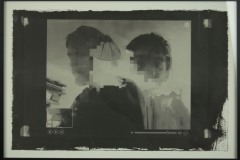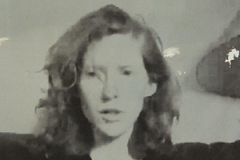At first sight, the image does not resemble the cadaver, but it could be that the strangeness of a cadaver is also the strangeness of the image. What we call the mortal remains evades the usual categories: something is there before us that is neither the living person himself nor any sort of reality, neither the same as the one who was alive, nor another thing. -Maurice Blanchot Two Versions of the Imaginary
Photographic Skeuomorphs are salt prints made from digital negatives. Salt prints are one of the many early photographic processes practiced in the mid nineteenth century. The process is simple and is made with salt, silver nitrate, a negative and ultra violet light to produce a photograph. The images for this series were captured from screen shots during skype conversations. A skeuomorph is a design technique that takes something new and makes it look older and more familiar. A good example is the calculator on your computer which uses images of buttons to represent a physical calculator. We see these all the time perhaps without even realizing it.
Just as I became involved with photography in the late 90’s it began a switch over to digital. I often wonder what is a photograph now and how has it impacted our lives? Photography is so important to us, that we’ve put cameras in our phones. Simply put, photography symbolizes loss. It is our attempt to capture a moment in time that we know we are losing. Hiroshi Sugimoto once said in his art 21 interview that the very idea of time brings awareness to death. This is what photography does for me. Photographic Skeuomorphs attempts to combine early photographic techniques with contemporary technologies. Just as photography is a tool for archiving memories, many other developing technologies are attempting to help ease existential dilemmas. These images articulate our age old struggles with connectivity and archiving as they continue in a digital era.


